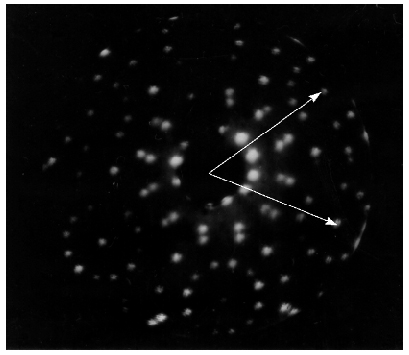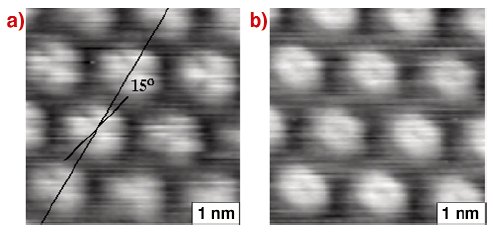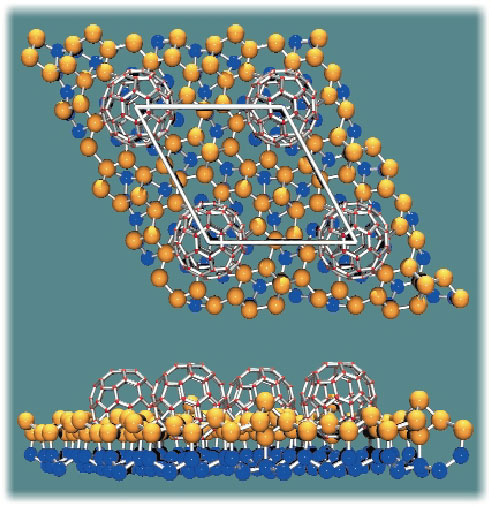- Home
- Users & Science
- Scientific Documentation
- ESRF Highlights
- ESRF Highlights 2003
- Surface and Interface Science
- Structure of the C60/Ge(111)- (13x13)R14° Surface Reconstruction
Structure of the C60/Ge(111)- (13x13)R14° Surface Reconstruction
The discovery of superconductivity as well as other fascinating properties of C60-based materials has stimulated a large number of experimental investigations on the adsorption and growth of C60 molecules on metals and semiconductors [1]. The understanding of interfacial interactions constitutes one of the most important goals of the research in this area. However, charge transfer and local chemical-bond formation from metal and semiconductor surfaces to C60 adsorbates still need a more exhaustive understanding. Here we present a detailed analysis of the structure of the (![]() 13x
13x![]() 13)R14° reconstruction of C60 on Ge(111).
13)R14° reconstruction of C60 on Ge(111).
 |
|
Fig. 97: LEED image of the C60/Ge(111)-(131/2x131/2)R14 superstructure, which forms two domains, rotated against each other by 28º as marked by the arrows. |
The bulk terminated Ge(111) surface consists of a buckled layer of hexagons, which provide threefold co-ordinated adsorption sites. Since each Ge surface atom exhibits one unsaturated "dangling" bond, the Ge(111) surface is unstable towards the formation of an ad-atom decorated, c(2x8) surface reconstruction. Ge(111)-c(2x8) surfaces have extensively been studied using a variety of methods such as low-energy electron diffraction (LEED), scanning tunnelling microscopy (STM), grazing surface x-ray diffraction (GIXRD) and ab initio methods. Upon adsorption of C60 onto the clean Ge(111)-c(2x8) surface and annealing to above 500°C, a (![]() 13x
13x![]() 13)R14° reconstruction forms, which is amazingly stable. Figure 97 shows a LEED pattern. Figure 98 shows two STM images with the hexagonal arrangement of C60 molecules on Ge(111) recorded with a sample bias of (a) +2.0 V and (b) 2.0 V, i.e. imaging empty and occupied states of C60, respectively. In contrast to the behaviour on other surfaces, C60 is immobile and desorbs as an intact molecule at above 600°C, which has to be compared with the bulk sublimation temperature of C60 of just about 200°C. We determined the atomic structure of the Ge(111):C60-(
13)R14° reconstruction forms, which is amazingly stable. Figure 97 shows a LEED pattern. Figure 98 shows two STM images with the hexagonal arrangement of C60 molecules on Ge(111) recorded with a sample bias of (a) +2.0 V and (b) 2.0 V, i.e. imaging empty and occupied states of C60, respectively. In contrast to the behaviour on other surfaces, C60 is immobile and desorbs as an intact molecule at above 600°C, which has to be compared with the bulk sublimation temperature of C60 of just about 200°C. We determined the atomic structure of the Ge(111):C60-(![]() 13xv13)R14° surface by using grazing-incidence X-ray diffraction (GIXRD) at the ID32 beamline and direct methods for the data analysis.
13xv13)R14° surface by using grazing-incidence X-ray diffraction (GIXRD) at the ID32 beamline and direct methods for the data analysis.
 |
|
Fig. 98: STM images of the C60/Ge(111)-( |
The sample was prepared in the ID32 surface characterisation laboratory, loaded into a portable UHV chamber, which was then mounted on the beamline's six-circle diffractometer. We measured around 1600 non-equivalent fractional order reflections. The analysis of the data set for this complex reconstruction was impossible by traditional means such as constructing and interpreting a two-dimensional Patterson map. For this reason we used three-dimensional direct methods [2]. The stronger peaks in the calculated "electronic density" map correspond to the contributions of the outermost surface Ge-bilayer. The analysis revealed the formation of a nano-pit in the unit cell (close to 1 nm in diameter), created by the removal of six Ge atoms, large enough to accommodate the fullerene molecule. Six Ge atoms from the topmost surface bilayer and three from the bilayer immediately underneath, i.e. the bottom of the pit, link each fullerene molecule to the surface with average C-Ge bond distances of 2.1 Å. The Ge atomic positions are otherwise almost bulk-like except for one adatom at a T4 position. The model is in perfect agreement with the STM images [1].
The fullerene molecules are located on the Ge surface with one of their hexagonal C-rings parallel to the surface. The refined structure with p3 symmetry is shown in Figure 99. It reinforces the idea that the surface adsorption of C60 molecules is mostly accomplished via surface holes instead of strong rehybridisation.
 |
|
Fig. 99: Projected (top) and lateral (bottom) views of the C60/Ge(111)-( |
References
[1] K.R. Wirth and J. Zegenhagen, Phys. Rev. B, 56, 9864-9870 (1997).
[2] X. Torrelles, J. Rius, C. Miravitlles and S. Ferrer, Surf. Sci. 423, 338-345 (1999).
Principal Publication and Authors
X. Torrelles (a), T.L. Lee (b), O. Bikondoa (c), J. Rius (a), J. Zegenhagen (b), to be published (2004).
(a) Institut de Ciència de Materials de Barcelona, ICMAB-CSIC (Spain)
(b) ESRF
(c) University of Manchester (UK)



